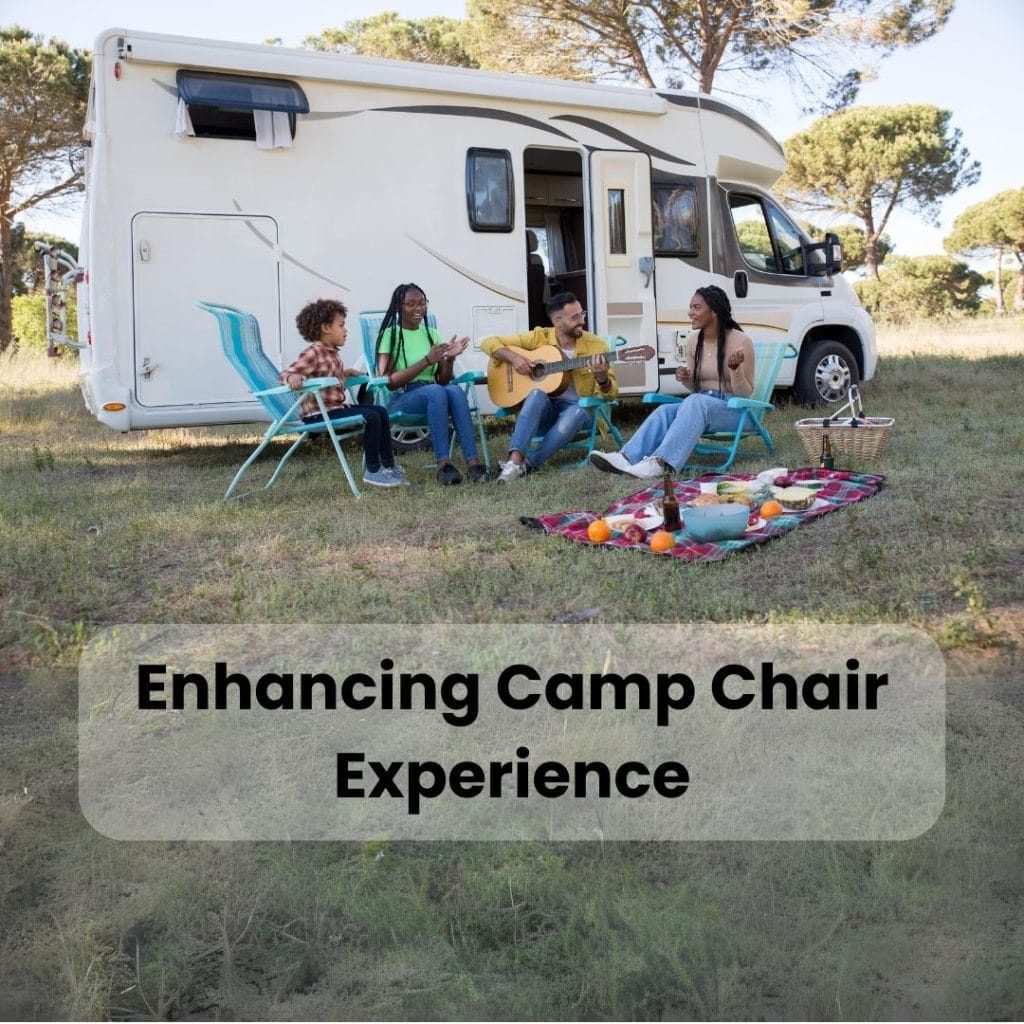Ergonomic camp chairs are transforming the way we experience the outdoors. These innovative seating solutions prioritize comfort and posture, taking into account the strain that traditional camp chairs can put on our bodies. Through their tailored designs, ergonomics in camp chairs offer extended comfort, making our outdoor adventures more enjoyable.
The Importance of Ergonomics in Camp Chairs for Extended Comfort
First and foremost, ergonomic camp chairs are designed with the human body in mind. The way they support your spine can lead to improved posture, reducing the risk of back pain and other common physical discomforts associated with poor sitting posture.
Secondly, since these chairs are adjustable, they can be adapted to fit each individual’s physique, enhancing comfort during extended periods of sitting.
Thirdly, the design of ergonomic camp chairs promote proper circulation. A correctly adjusted chair allows for better blood flow, preventing the feeling of numbness or pins and needles in your legs.
Fourthly, they can significantly enhance the overall camping experience. With ergonomic chairs, you can sit comfortably for longer periods, enabling you to better enjoy the serenity of the outdoors.
Fifthly, the comfort provided by these chairs can lead to better concentration and a more enjoyable social experience around the campfire.
Next, ergonomic camp chairs tend to be durable, offering long-term financial benefits as the need for replacements is less frequent.
Moreover, their practical design often includes additional features like cup holders and pockets, providing convenience that enhances the overall camping experience.
Eighthly, the compact and lightweight design of these chairs makes them easy to transport and store, an important feature in any camping gear.
Ninthly, these chairs can be easily cleaned and maintained, reducing the effort required in post-camping cleanup.
Finally, ergonomic camp chairs can also contribute to environmental sustainability. Many manufacturers are using more eco-friendly materials in their production, aligning with the environmentally conscious ethos of many campers.
What is ergonomics?
Ergonomics is the scientific discipline that focuses on designing and arranging products, systems, and environments to optimize human well-being and overall performance. It is the study of how people interact with their workspaces, tools, and tasks, with the goal of creating designs that minimize discomfort, reduce the risk of injury, and enhance productivity.
Ergonomics considers various factors, including the physical, cognitive, and psychological aspects of human capabilities and limitations. By taking these factors into account, ergonomics aims to ensure that the design of objects, equipment, and workspaces is suited to the people who will use them, making their interactions more efficient, comfortable, and safe.
In the context of office furniture, ergonomic design principles are applied to create chairs, desks, keyboards, and other workplace elements that support good posture, reduce the risk of musculoskeletal disorders, and promote overall well-being, ultimately leading to increased productivity and job satisfaction.
What is an ergonomic chair?
An ergonomic chair is a specialized type of chair designed to provide optimal support and comfort for the human body, particularly when sitting for extended periods. These chairs are carefully engineered with ergonomic principles in mind to promote good posture and reduce the risk of musculoskeletal issues, such as back pain and strain.
Key features of ergonomic chairs typically include:
- Adjustable seat height: Users can customize the chair’s height to ensure that their feet are flat on the floor or on a footrest, promoting proper alignment of the spine.
- Lumbar support: Ergonomic chairs offer lumbar (lower back) support to maintain the natural curve of the spine and prevent slouching.
- Adjustable armrests: Armrests that can be adjusted in height and width help users maintain a relaxed and comfortable arm position, reducing strain on the shoulders and neck.
- Seat depth adjustment: The ability to adjust the depth of the seat ensures that users can sit with their back against the chair while leaving a few inches of space between the front edge of the seat and their knees.
- Reclining and tilt mechanisms: Many ergonomic chairs allow users to recline and lock the chair in various positions to encourage movement and reduce pressure on the spine and lower back.
- Swivel base: The chair should swivel easily, allowing users to access different areas of their workspace without straining.
- Breathable, comfortable materials: Ergonomic chairs often feature cushioning, mesh, or other materials designed to provide comfort and airflow, ensuring a pleasant sitting experience.
- High-quality wheels and a stable base: These components facilitate easy movement and stability.
- Headrest (optional): Some ergonomic chairs come with adjustable headrests to support the neck and head.
Ergonomic chairs are popular in office settings, where people spend a significant portion of their day sitting at a desk. They aim to reduce the physical discomfort and health risks associated with prolonged sitting, ultimately enhancing productivity and overall well-being.
What are the health benefits of sitting ergonomically?
Sitting ergonomically can offer several health benefits, as it promotes proper posture and reduces the strain on the body during extended periods of sitting. Here are some of the key health advantages of sitting ergonomically:
- Reduced Risk of Back Pain: Ergonomic seating supports the natural curve of the spine, reducing the risk of developing lower back pain and discomfort.
- Prevention of Neck and Shoulder Pain: Proper ergonomic posture minimizes strain on the neck and shoulder muscles, decreasing the likelihood of tension and pain in these areas.
- Lower Risk of Musculoskeletal Disorders: Ergonomic seating helps prevent musculoskeletal disorders, such as carpal tunnel syndrome and repetitive strain injuries, which can result from poor posture and improper ergonomics.
- Improved Circulation: Ergonomic chairs often feature designs that facilitate better blood circulation, reducing the risk of blood pooling in the legs and feet, and the development of varicose veins.
- Reduced Risk of Headaches: Proper alignment of the head and neck in ergonomic seating can help prevent tension headaches and migraines.
- Enhanced Lung Function: Good posture allows for better lung expansion and function, leading to improved breathing and oxygen intake.
- Optimal Digestion: Sitting ergonomically can also aid in better digestion by preventing compression of the abdomen and maintaining a healthy alignment of internal organs.
- Less Fatigue and Enhanced Energy: Ergonomic seating reduces physical fatigue, helping individuals stay more alert and energetic throughout the day.
- Improved Joint Health: Ergonomic chairs minimize pressure on joints, leading to a lower risk of joint pain and discomfort, particularly in the hips and knees.
- Prevention of Postural Problems: Sitting ergonomically from an early age can help prevent the development of poor postural habits that may lead to chronic postural issues in the future.
- Mental Health Benefits: Improved physical comfort and reduced discomfort can have positive effects on mental health, contributing to reduced stress and improved mood.
- Increased Longevity and Comfort: Ergonomically designed chairs are often more durable and comfortable, potentially resulting in long-term cost savings and less need for replacements.
How to choose the best ergonomic Camp chairs
Choosing the best ergonomic camp chairs involves considering several crucial factors. Here are some guidelines to help you make the right choice:
- Comfort and Support: Look for a chair that provides excellent comfort and support, particularly for the lower back. The chair should promote a natural spinal alignment and evenly distribute your body weight.
- Adjustability: The best ergonomic camp chairs come with adjustable features, allowing you to customize the chair’s fit to your specific needs. This could include adjustable seat height, backrest tilt, armrests, and headrest.
- Quality of Materials: Check the quality of the materials used in the chair. It should be built with sturdy, long-lasting materials that can withstand regular use. The fabric should be breathable to prevent sweating and discomfort during prolonged sitting.
- Size and Weight Capacity: The chair should be appropriately sized to fit your body type and have a weight capacity that accommodates your weight.
- Ease of Portability: If you plan to use the chair for camping or outdoor activities, it should be lightweight and easy to fold and carry.
- Price: While ergonomic chairs can be more expensive than regular chairs, consider it as an investment in your comfort and health. However, always compare prices from different brands to ensure you’re getting the best value for your money.
- Customer Reviews: Before buying, read customer reviews to get a real-world perspective on the chair’s comfort, durability, and overall quality.
- Warranty: Consider chairs that come with a warranty. This ensures you can get help or a replacement if you encounter any issues with the chair.
Why should business owners invest in an ergonomic Camp chair range for their office workers?
Business owners should consider investing in an ergonomic Camp chair range for their office workers due to the following reasons:
- Improved Productivity and Efficiency: Ergonomic camp chairs are designed to provide optimal comfort, reducing physical stress and fatigue. This can lead to increased productivity and efficiency, as employees are less prone to distractions or discomfort.
- Health and Well-being: These chairs support the correct posture, reducing the risk of musculoskeletal disorders such as back pain, carpal tunnel syndrome, or neck strain. Hence, investing in ergonomic camp chairs contributes to the health and well-being of employees.
- Boost Employee Morale: By investing in quality camp chairs, businesses demonstrate care for their employees’ comfort and health. This can enhance job satisfaction, improve morale, and lead to greater employee retention.
- Flexibility and Adaptability: Ergonomic camp chairs often come with several adjustable features, allowing each user to customize the chair to fit their specific needs. This adaptability ensures that the chairs can serve a diverse range of employees, irrespective of their body type or personal preferences.
- Reduced Absenteeism: By minimizing discomfort and health risks associated with prolonged sitting, ergonomic camp chairs can help reduce employee absenteeism.
- Cost-Effective: While the initial investment might be higher than traditional office chairs, the long-term benefits of ergonomic chairs in terms of improved health, reduced absenteeism, and increased productivity make them a cost-effective choice for businesses.
- Improved Corporate Image: Prioritizing ergonomics can contribute to a positive corporate image, illustrating a company’s commitment to employee welfare and sustainable business practices.
- Compliance with Health and Safety Regulations: Investing in ergonomic camp chairs can help businesses comply with occupational health and safety regulations, potentially avoiding fines or legal issues.
Conclusion
In conclusion, ergonomic camp chairs offer significant benefits, ranging from improved physical comfort and health to enhanced productivity and morale. They are an investment worth considering both for personal recreational use and in professional settings like offices. Prioritizing ergonomics, especially in the form of ergonomic camp chairs, reflects a commitment to health, comfort, and efficiency. It’s a choice that yields long-term rewards, fostering an environment conducive to relaxation and productivity. Therefore, whether you’re a business owner or an outdoor enthusiast, incorporating ergonomic camp chairs into your routine is a decision well worth considering.






